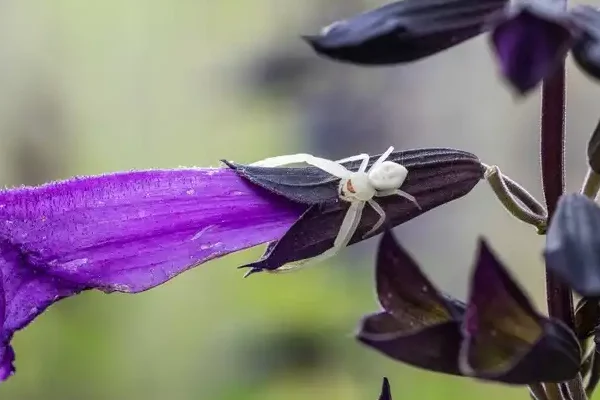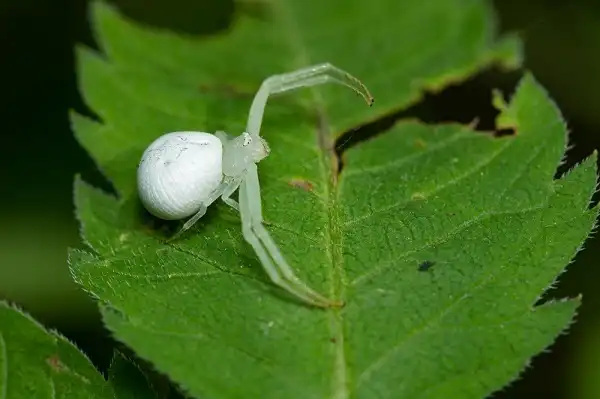From its unusual name to its unique set of characteristics, the crab spider stands out from other species. As an expert in spiders and insects, I want to share my knowledge about this remarkable arachnid with those who may be unfamiliar or misinformed on the topic. You’ll learn how different these small critters are from their eight-legged relatives, what makes them so difficult to identify, where they’re most commonly found around the world, and why we should appreciate them as a vital part of our natural ecosystems.

Crab Spider Description
The crab spider is a fascinating arachnid that boasts a plethora of unique characteristics. Unlike other spider species, the crab spider’s body shape and leg configuration give it the appearance of a miniature crustacean. In addition, these arachnids are highly adaptable, allowing them to blend seamlessly into their surroundings, making them difficult for predators and prey to spot. One of the most notable features of the crab spider is its ability to change color to match its environment. This allows the spider to ambush its prey by blending in with the surrounding flora. Additionally, the crab spider is incredibly agile and can move quickly when stalking its prey.
Crab Spider Habitat
The habitat of the crab spider varies greatly, depending on the species. Some crab spiders prefer the forest floor, while others can be found in fields, gardens, or even on the bark of trees. They can be found on virtually all continents, with some species thriving in temperate climates while others prefer tropical areas. Crab spiders are also known to use their surroundings to their advantage when hunting. They often wait patiently on flowers, blending in with petals and lying in wait for unsuspecting prey to come within striking distance. While crab spiders may be found in many different habitats, they all share one commonality: they are vital components of their ecosystems. These spiders are natural predators, helping to control the populations of smaller insects and other arthropods. By keeping these populations in check, they help to maintain a healthy ecological balance, ensuring that the ecosystem remains healthy.
Crab Spider Diet
Crab spiders have a highly specialized diet. These arachnids are known as ambush predators, which means that they wait in a camouflaged position until their prey comes close enough to capture. Their diet consists of small insects, such as bees, butterflies, and other spiders. Interestingly, crab spiders also have a preference for certain types of prey. For example, some species of crab spiders are known to specifically target bees, while others prefer butterflies. This is likely due to the availability of prey in their specific habitats. The diet of the crab spider is highly specialized, consisting mainly of small insects. Their unique hunting method and preference for certain prey make them fascinating arachnids to study. Their role in controlling insect populations highlights their importance in the natural world.

Crab Spider Size
Crab spiders come in a variety of sizes, with most species ranging in length from 2-22 millimeters. The size of a crab spider typically depends on its species, as well as its sex. Female crab spiders are usually larger than males, and some species of crab spiders have females that are more than ten times larger than males. Although crab spiders are small in size, they are formidable predators. Their size allows them to move quickly and easily on their prey, making them efficient hunters. Additionally, their relatively small size helps them to blend in with their surroundings, making it easier for them to ambush their prey without being detected. Despite their small size, crab spiders can have a significant impact on their environment. Their ability to control insect populations can help to maintain a balanced ecosystem, which is vital to the survival of many other animal and plant species.
Crab Spider Lifespan
The lifespan of a crab spider varies depending on its species, as well as environmental factors such as temperature, humidity, and availability of prey. Generally, crab spiders can live for several months to a year. Female crab spiders tend to have longer lifespans than males as they have a greater need to survive in order to reproduce. Some species of crab spiders have been known to live up to 2 years in the wild. However, their lifespan is not always guaranteed as they face many predators and environmental hazards. Parasitic wasps, birds, and other spiders are known to prey on crab spiders, while harsh weather conditions can also be a threat to their survival. Crab spiders have a unique reproductive strategy that enables them to pass on their genes even if they do not survive for long. Females lay eggs in silk egg sacs which they guard until they hatch. Young spiders go through several stages of development before reaching adulthood, which can take several weeks to several months.
Crab Spider Behavior
Crab spiders are known for their unique and fascinating behavior. These arachnids are ambush predators, which means that they do not actively search for their prey. Rather, they wait patiently for their prey to come to them. One of the most interesting behaviors of crab spiders is their ability to change color to match their surroundings. This process, known as camouflage, helps them to blend in with their environment and ambush their prey without being detected. Some species of crab spiders can change color within a matter of days, while others take longer to adjust to their surroundings. Crab spiders are also known for their territorial behavior. They often guard their territory fiercely and will attack other spiders or insects that encroach on their space. In addition to their territorial behavior, crab spiders are also known for their mating behavior. Males will often approach females and present them with a gift of food or silk as a courtship gesture. If the female accepts the gift, the male may begin to approach her more closely, and eventually, the two will mate. One interesting fact about crab spider behavior is that some species are known to use silk to anchor themselves to flowers. This behavior, known as ballooning, allows them to catch a ride on the wind and potentially travel long distances in search of new habitats.

Crab Spider Speed
Crab spiders are not known for their speed as they rely on their ambush tactics to catch their prey. However, when they do move, they can travel relatively quickly for their size. Some species of crab spiders can move at a rate of up to 0.15 meters per second, which is quite impressive considering their small size. In addition to their ability to move quickly, crab spiders also have excellent reflexes. They are able to react quickly to changes in their environment, such as the movement of their prey, and can strike with lightning-fast speed. This allows them to capture their prey before it has a chance to escape. Overall, while crab spiders may not be the fastest predators in the animal kingdom, they have evolved a number of adaptations that allow them to be highly effective ambush hunters. From their ability to change color to their lightning-fast reflexes, these small arachnids are truly remarkable creatures that have adapted in fascinating ways to thrive in their environments.
Crab Spider Hunting
Crab spider hunting behavior is fascinating and highly effective. As ambush predators, crab spiders do not actively pursue their prey. Instead, they patiently wait for their prey to come to them. When prey comes within striking distance, the crab spider uses its lightning-fast reflexes to capture the prey before it can escape. Crab spiders also exhibit highly territorial behavior. They aggressively defend their territory and will attack any intruders, including other spiders and insects. This territorial behavior is not limited to their hunting grounds.
Interestingly, the behavior of crab spiders during hunting is not solely instinctive. These creatures have been observed to display remarkable cognitive abilities, including learning and memory. They are able to associate specific colors and shapes with the presence of prey and adjust their behavior accordingly. Crab spiders also have highly specialized sensory organs that allow them to detect prey from a distance. These sensory organs include specialized hairs on their legs that are highly sensitive to vibrations in the air, enabling them to detect the movement of prey.
Crab Spider Types
Although all crab spiders belong to the same family, Thomisidae, there is a large variety of species. Some of the most common and easily recognizable types of crab spiders include:
• Xysticus cristatus – Also known as the European Crab Spider, this species has a mottled yellow or brown coloration with black stripes. It is found in Europe, North Africa and parts of Asia.
• Misumenoides formosipes – Commonly referred to as the White-banded Crab Spiders, these spiders are recognized by their white bands across the abdomen. They are native to North America and can be found throughout Canada and much of the United States.
• Thomisus spectabilis – Also known as the Spectacular Crab Spider, this species has a distinctive red and yellow pattern on its abdomen. It is native to Southeast Asia, including India, Thailand, and Malaysia.
• Olios giganteus – Commonly known as the Giant Crab Spider, this species is easily recognizable by its large size. It is found in tropical regions of Africa and Southeast Asia.
• Heteropoda venatoria – The Huntsman Spider, or a giant crab spider, is an apt hunter with impressive speed and agility. It can be found throughout Europe and parts of Asia.
Each species of crab spider has different hunting techniques and behaviors that have enabled them to survive in their environment for millions of years. By studying their behavior, we can gain a greater appreciation for the diversity and complexity of life on Earth.

Conclusion
Crab spiders are remarkable creatures that have evolved a variety of adaptations to enable them to survive and thrive in the wild. From their ability to change color for camouflage to their lightning-fast reflexes and highly territorial behavior, crab spiders exhibit an impressive range of behaviors that make them effective predators. By studying their behavior and adaptations, we can gain a greater understanding of the complexity and diversity of life on Earth. The incredible hunting capabilities of crab spiders remind us just how much there is still left to learn about the natural world.
Frequently Asked Question

